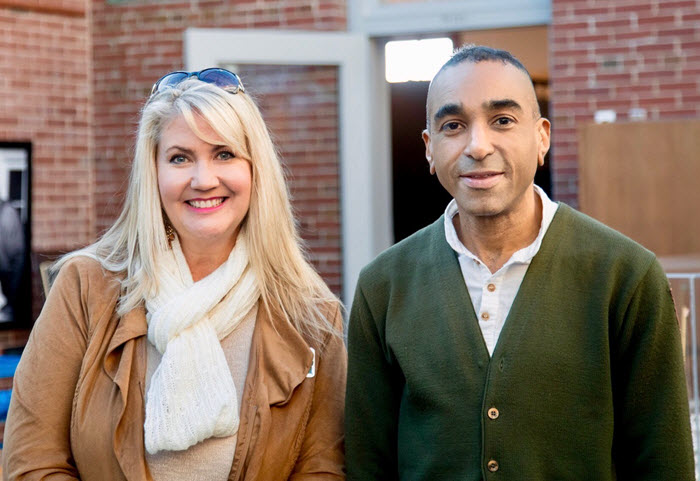What is WikiTree with Founder Chris Whitten
Show Notes: When it comes to choosing an online family tree, there are lots of different options. It can be a challenging decision as to where to put yours. In this video and show notes article we’re going to take a look at WikiTree.com. You’ll learn what it is, how you to use it effectively, and how you can use it in conjunction with your own private family tree on your own computer. My guest is Chris Witten, the President and Founder of WikiTree.
Watch the Video
Download the Show Notes Cheat Sheet (Premium Membership required)
What is Wiki Tree?
Lisa: We are always interested in those websites that are going to help us build out our family tree, and learn more about our family history. WikiTree has been doing that for several years now. Please tell people about what you do at WikiTree.
Chris: WikiTree is completely free. It’s open to everybody. It’s a genealogy community. So, it’s all for collaboration. We’re growing a single-family tree.
We like to say it’s not your tree or my tree, it’s our tree that we all share. A lot of people are familiar with the FamilySearch tree, and it’s somewhat like that. There’s also Genie and a few others around the world that are doing the single family tree idea where everybody collaborates in one environment.
What sets WikiTree apart, I think, is really that we are a community. It’s very much a supportive group. We place a big emphasis on sourcing. So, we’re the most accurate, single-family tree available. And we have a lot of fun.
Is the WikiTree Family Tree Accurate?
Lisa: I know that for many people it makes them happy when they hear that there is an emphasis on sourcing. Of course, if we get connected with a tree that isn’t correct, then we have more problems than we started with. Tell us a little bit more about that. What are the some of the mechanisms on your website that help and facilitate the sourcing of the information that is going into the trees?
Chris: Well, first and foremost, we ask that every piece of information that somebody puts on WikiTree has a source. So even if you’re saying this is from my Aunt Sally, or this is the family tree that was handed down to me, you have to at least say where it came from. And then that gives people a starting point for the collaboration. If somebody else then comes along and says, “Well, you know what, I have different information. What’s your source?” You can then compare and come to a conclusion.
Lisa: That does sound a bit like the FamilySearch tree in terms of it being one tree. Does that create any other challenges? What do people disagree about when it comes to the information that they’re putting on the website?
Chris: Oh, yeah, people disagree all the time. I mean, that’s what happens when human beings get together and try to work together. They will argue and have problems.
Probably one of the most really special things about WikiTree is this culture that we’ve developed over the years, because we’ve been around 14 years. It’s very much community based, like I don’t know, if I mentioned, it’s totally free, free for everybody. And we don’t have any full time employees. This isn’t run by this big team of people. It’s almost entirely volunteer based. The team we have is just part time and they are there to support the community. So there is a whole set of policies and procedures that’s developed over the years from the ground up to work out problems like this.
How Can WikiTree be Free?
Lisa: How did you decide from the beginning that free was going to be the price? And how do you keep the lights on when you do it for free? What’s the model there?
Chris: It has been challenging at times. For the first seven years I did this, and it was a struggle. We quite honestly lost money. But we figured out and had to reach a point where we’re getting enough visitors that we can pay for ourselves with advertising. We now get about a million and a half visitors a month. So, we do have the big advertisers. Like if you come on WikiTree, you’ll see MyHeritage and Ancestry ads, and ads for DNA tests. But if you sign our honor code, and you register as a member, the ads essentially disappear. Members don’t even see ads. And for non-members, the ads they see are not as offensive as what you see in a lot of places out there on the internet. So really, it’s just a balance that we had to reach. And we reached it years ago. So now it’s quite comfortable where the community doesn’t even have to see the ads. It’s all free for everybody.
How to Get Started with WikiTree
Lisa: What do you recommend is the best way to get engaged with the website?
Chris: Yeah, that’s a good question. The biggest complaint about WikiTree is that it can be overwhelming, because it’s a very large community. And it’s evolved over a long time. It’s very elaborate, like, there are just thousands of little corners of WikiTree where you have people collaborating on their Mayflower ancestors over here, and working on translating obscure Latin documents over there. There are also a lot of independent developers who have created tools that work with WikiTree. And so some of those can be a little bit complicated and intimidating. We try to keep it all simple, but we do realize that it can be a bit much for the new user. So, the first thing you do is you just register, just log in, and you get that free Guest account.
What is the WikiTree Honor Code?
If you want to put something on your profile, you upgrade that to what we call a family member account. A lot of us have family member accounts for our family members. So, the third step is to sign that honor code that I mentioned before, and that’s just these 10 basic principles. Things like saying, we cite sources, that’s number one. We collaborate, we work together, we give credit, when credit is due, we respect copyrights, we respect privacy. So, it’s this very simple 10 point Honor Code. Read it in two minutes. And as long as you agree with that, you say yes, and then you move forward to the next step.
How to Get Help with WikiTree
If you want help, it’s there. There’s this really vibrant community in the discussion forum. There’s live online chat or video chats you can do. There are one on one personal mentors you can get. There are training programs in various projects. So you can be as involved as you want to be in whatever areas you want to be involved in. I just recommend taking it one step at a time and trying not to get overwhelmed.
Can I Export WikiTree and Import it into my Genealogy Software?
Lisa: Right. I know many people will have software that they use on their computer that they use to build their family tree. What’s the balance between using your own personally controlled software to build your family and using the collaborative online WikiTree? It sounds like you can benefit from the collective knowledge. Is there a way to export portions of the tree that you want to have in your own database? How do they interact with each other?
Chris: Well, we do have a GEDCOM, and import / export capability. I’m sure a lot of your listeners know what GEDCOM is. It’s a terrific, standardized format developed many years ago by Family Search. So that that standard is almost universal.
Watch and read: All About GEDCOM (interview with Gordon Clarke, FamilySearch’s GEDCOM Developer Relations Manager)
Whatever program you’re using, or website you’re using, will almost certainly allow you to import and export trees in this format. Because it’s a completely collaborative environment where we’re all working together, you can’t simply keep your tree in sync with WikiTree, because that would involve overriding what other people have done really. Like if you could just click a button and import your whole tree that would end up creating these records that would overwrite the collaborative work.
The export is just like it works anywhere else. If you want to download a tree, you can. If you want to upload, you just have to do it one profile at a time. What we do is, you would upload your GEDCOM and it would say, “this it looks like of the thousand people in your tree, 100 seem to already exist on WikiTree.” So take a look at these potential matches.
And by the way, that’s a great way to do a quick search if you want to see if your ancestors are already on WikiTree. So, you get this GED Compare process we call it, and you can look one at a time, left and right side. You know, here’s what’s on WikiTree, here’s what’s in your system. Do you want to move this? Do you want to move that? And then you would cite your sources at the bottom.
WikiTree Search Strategies
Lisa: You mentioned search. When we go to the homepage, we see that we can search. There’s a first name, last name, there’s letters for the last name, we can do surname searches, etc. Does WikiTree support any other kind of searching or search operators? Is there a Search Help page to help us make sure that we’re finding what we want to find?
Chris: Sure. If you go ahead and just try a search on WikiTree.com, you’ll see it right there. If you don’t enter anything, if you just click the search button, you would be taken to the search page that has more advanced options on it and has all kinds of help links. And if you’re looking for somebody, and you can’t find them, or you’re unclear on how to use the search engine, click over to the forum and just ask.
DNA on WikiTree
Lisa: I also noticed that on the homepage, it said something about DNA connections, and people are definitely interested in DNA, and it’s the way it intersects with genealogy. How does that work on WikiTree? What should we be looking for in terms of our DNA tree test connections?
Chris: DNA for us is a way to verify the tree that we’re growing, The basic work always has to be done in the traditional way, right? Like, genealogy has grown in the way we’ve always done it through records. That’s the only way you’re going to get names. But that traditional genealogy research can then be verified, or disproven with DNA. So, that’s what a lot of members do on WikiTree.
We do use DNA, and we facilitate this in some interesting ways that are done nowhere else. For example, on every single profile, every person profile, every ancestor, every cousin, were a DNA test, or more than one DNA test has been taken, which could help verify connections to that ancestor, it’ll show that. It’ll say, Lisa Louise Cooke has taken an Ancestry.com test. And it’s on GedMatch. And Chris witness taken a DNA test that I got from MyHeritage, and it’s also on GedMatch, click here. And you can compare those two. And that’ll take you right to GedMatch, where you can look to see if we match the way that we should. And on that profile on like, let’s say we’re first cousins, and so we share grandparent. It’ll say then that we would expect to share 12% of our DNA. So, if we then go to GedMatch and we don’t share 12% that’s a red flag. Or if we do, that’s a big step to confirmation.
Privacy Controls on WikiTree
Lisa: Finally, I want to ask you about privacy because it mentions privacy on your site as well. I know that’s on the forefront of people’s minds. What kind of privacy controls can people expect a WikiTree?
Chris: We take privacy really seriously. To me, and especially to the non-genealogist family members, if you can’t connect living people to the tree, it loses a lot of its family history and a lot of its interest. So, we need to be able to connect living people. And we want to include family photos. Photos of living people. But if you’re doing that, you need privacy controls.
Profiles have seven different levels. And you have some options for customizing. If you have somebody who is not a WikiTree member, but they’re living, they have to be unlisted. We have this privacy level called unlisted. That essentially means that their information cannot be found on WikiTree, except by you and your family members that you specifically put on what we call the trusted list. And then we have four different levels of private, but with a public biography. Private but with a public tree. And so, these are all levels that you can choose.
If you’re a member, there’s privacy around your own profile. And then for every non-living person, the recently deceased can be private but once somebody was born 100 years ago or died 100 years ago born 150 years ago, they have to be fully open. They have to be fully collaborative. So, every profile has those seven privacy levels. You have a fair amount of control on your modern family history about what’s private and what isn’t. But then for the sake of collaboration, the deeper ancestry is meant to be broad collaboration, because that’s really what WikiTree is all about.
How to Get the Most Out of WikiTree
Lisa: I can’t let you go without asking you, what is your best advice for us as we make the most out of using the website?
Chris: Just come try it. It’s free. You have nothing to lose. And there’s a community of people to support you.
Lisa: Sounds like folks are going to find other friendly genealogists who have the same interest in family history as we do. That’s a nice place to be. Chris Witten, thank you so much for joining us here today. I appreciate it.
Chris: Thanks, Lisa.
Resources
- Download the Show Notes Cheat Sheet including video time stamps. (Premium Membership required)
- Watch and read: All About GEDCOM An interview with Gordon Clarke, FamilySearch’s GEDCOM Developer Relations Manager. (Free)
- Watch How to Take Control of Preserving Your Family Tree Information. (Premium Membership required)
Comments:
I’d love to hear from you. Have you used WikiTree? Do you have a success story? Do you have a problem story? We’d love to learn from each other. So head down to the comments below and leave us a comment and let us know what your experience with WikiTree.com is.
Reconstructing Ancestors’ Lives with Newspapers
Show Notes: Reconstructing with Ancestors’ Lives with Newspapers
In this video, Lisa Louise Cooke and Jenny Ashcraft from Newspapers.com discuss how to use newspapers to fill in the missing stories in your ancestors’ lives. Jenny shares strategic tips on finding unique information many researchers miss.
Interview with Jenny Ashcraft of Newspapers.com. (Edited for clarity)
Download the ad-free Show Notes handout (including a bonus search strategy checklist) (Premium Membership required)
For a limited time get 20% off Newspapers.com here. Use our coupon code: genealogygems
Lisa: Let’s talk about one of my favorite things, which is reconstructing the life story of an ancestor. Not just the names, dates, places. We want to expand that out to include the events, the people, what they did in their life. Newspapers really can tell that kind of story for anybody, can’t they?
Jenny: It’s true. We love those vital records, right? As genealogists we’d love to have those birth, marriage and death records. But what happened in between? Newspapers are a wonderful resource for kind of bringing color and stories to your ancestors’ life. How did their life impact history? How did history impact their life? You can try to find those stories and piece together a story of their life through newspapers.
Lisa: And the newspaper articles don’t have to actually name our relative to be really valuable in reconstructing their story. We can look at the family tree and see what we’ve found so far. We can find supporting evidence and information that helps tell us what was happening at the time in their life.
Jenny: Exactly! Because sometimes you might not find your ancestors name or a newspaper article about a specific event. But what you can do is create a context for what was happening, what was happening in their family, what was happening in their community, the country and the world. Even if you can’t find a specific article about them, you can still create a context for what their experiences would have been.
Lisa: Well, I know you’re doing to share your grandfather’s story today and I just think it’s a perfect example. We’ll use your grandfather as kind of a test case and have you kind of show us the reconstruction process. Where did you start?
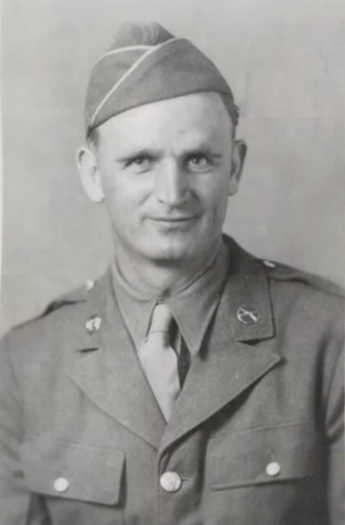
Jenny’s grandfather Lamar Norton
Getting Started Using Newspapers for Genealogy
(03:17) Jenny: I started looking for my grandfather’s birth announcement and I couldn’t find it.
He lived in a tiny town called Panguitch, Utah. The local newspaper was just a short little run of a newspaper, only a few years. It was a weekly, and the birth announcement was not there!
I thought, okay, if I can’t find my grandfather’s birth announcement, I’ll look for the family. And I found a birth announcement for his older brother that was born just two years before him.
I started looking for other clippings that I might be able to find more information about my grandfather. I found just a few months before his birth. I found this little article about his father driving to purchase to seven passenger Paige automobiles. This is just months before my grandfather was born. And I’m thinking well, what is a Paige automobile? So, I searched for Paige automobiles, and found a picture of one. And even though my grandfather’s name is not in this clipping, but I’m starting to get a little context. This is the car that his father was going to purchase just before his birth. So that’s kind of fun!
All of these clippings they start to create a context for this little Norton family. My grandfather’s name was Lamar Norton. He was born in a small town in Panguitch, Utah. He was a father of seven, and a World War II veteran. I just wanted to learn a little bit more about his life.
Even though I couldn’t find a birth announcement, I started finding clippings about his family, his siblings, his parents, and it started to help me create a context for what the Norton family was experiencing in 1915 in Panguitch, Utah.
Lamar started to grow up. And his family moved to another very small town called LaPointe, Utah. He was living in the point when he met a young woman that would become his future wife. Her name was Velma Hollinger. I wanted to find out if they talked about their marriage in the paper. Was there a newspaper story? And what can we learn about their marriage?
Newspapers.com Marriage Index
(06:11) An effective way to search for marriages in the newspaper is by using the Marriage Index at Newspapers.com.
Our data science team at Ancestry, figured out how to use data intelligence to scour through all of the newspapers and extract marriage announcements and obituaries. There are like 250 million obituaries and 17 million marriage announcements. You can search for just marriage announcements.
Here’s how I searched for my grandfather’s marriage announcement in the Marriage Index. His last name was Lamar Norton, so I’m entered Lamar Norton in the Search tab. It brought up about 468,000 matches! So, I needed to filter the search. You can do that by using the button called result type and selecting. I could add a location and a date and filter those as well.
Next, I went to the map because I know the marriage was in Utah. So, I clicked on Utah on the map. This gave me 10 matches. As I looked through the list, I found his marriage announcement. This process allows you to search without going through all the clippings. You can search just for marriage announcements.
Lisa: That’s really slick. It’s nice that we can just run a simple search first, and then start making adjustments. We don’t necessarily have to mark everything on the very first search time.
Jenny: You don’t have to. There are so many filters. If you find yourself with too many results, start using those filters and narrow the years or narrow the location.
I happen to know that he was born in Utah. So, I just quickly added Utah onto that filter. But if there were too many things. I could keep filtering and filtering until I just have a very few results to choose from.
Lamar and his now wife, Velma started their young family and they had two little children. But this simple life for the Norton’s was not going to last because in just a very few short years, we went to war. The headlines of the newspapers announce the U.S. entry.
With a wife and two young children, Lamar hoped that he wasn’t going to be drafted. But when it came time to register Lamar and some of his friends loaded in a car and they headed to the registration office to register for the draft. Apparently, they discussed on the way who might or might not get drafted and everybody was sure that he was not going to get drafted because he was the only one married with two small children. Well, it was quite a shock just days later, when Lamar received notice that he had been drafted and had just days to report.
It was apparently quite a big deal in the community that this young father had been drafted. I was sure that there must be something about it in the newspaper. But when I searched Lamar Norton, I couldn’t find it in the tiny, small-town paper.
I started adjusting my search parameters and eventually I did find it was published in the paper. However, the quality of the printing was really poor. His name is Lamar Norton, but I could hardly even see that. When I adjusted my parameters to just search Lamar and Norton, in the right timeframe in the right town, that’s when I found this little announcement that he had been drafted.
Expanding Your Newspaper Search
(10:45) There he was heading off to war, knowing that my grandmother is going to be left at home with two small children. I thought, what was she going to do? What’s her life going to be like now that her young husband is heading off to war. She doesn’t know when he’s going to come back, or there’s always the possibility that he might not come back.
Asking questions about the story you’ve found so far can help you develop new searches. These questions that I had certainly prompted me to start searching for my grandmother in the paper. er name was Velma Norton. Sure enough, I found an article that shows that she decided to go home and live with her parents while her husband is off fighting. I just searched for her name, and then again, adjusted the search parameters for that same time period.
Lamar headed off to basic training, and in this training he learns how to repair tanks. They start training him to become a mechanic, and he was assigned to serve with Patton’s Third Army. Well, through the newspapers I learned that right before he headed off to Europe, he was able to come home one last time on furlough. I found a little announcement about it in the paper. He’s home visiting his wife and his two children and his parents. I find it very interesting also because of the date of the article, November 9, 1944. If you’re familiar with World War II history, then you may know that there was about to be a very big, pivotal battle in World War II. It was one of the costliest battles of the war. It was the Battle of the Bulge. Well, Lamar headed off to Europe, and for the next several months, he was involved in horrific fighting.
He came home from the war with something that was called Shell Shock. Today, we know it as PTSD. I remember, as a little girl, that if a balloon popped, or if there was a loud clap of thunder, he would just dive under the table. It was just kind of an involuntary reaction due to such tremendous fighting that he endured. There was one instance when he was repairing a tank. The track had come off the tank, and he was under fire in the tank surrounded by the enemy. Still, he managed to repair this tank and get the tank on the road. For that he received a Bronze Star.
Maybe you have an ancestor that fought in World War II or another military battle. Perhaps they came home but they didn’t want to talk about it. I know that my grandfather’s brother said at his funeral, when your grandfather came home, he wanted to forget what he had seen.
In addition to searching for your ancestor, search on other aspects of their life such as the battalion or unit they served in. If you know a specific battle that they participated in, you can learn about that battle. It’s just like we talked about creating a context. Even though all of the Battle of the Bulge newspaper articles I read didn’t talk about my grandfather specifically, I was able to get a context and understand this traumatic fighting that he endured and what that might have been like.
Another search strategy is to look for their obituary. Oftentimes veterans’ obituaries will list what unit they served in or what battles they may have participated in.
Lisa: Well, that’s a great point. We can take records we’ve already found and go back and pull those pieces of information off and then go search them in the newspapers.
Jenny: Yes indeed.
Now, the Third Army Patton’s Third Army, following the Battle of the Bulge, they started moving across Germany. On April 4, 1945, they came across a concentration camp, and it was called Ohrdruf concentration camp. This was the very first concentration camp that was liberated by the Americans.
These young men just couldn’t believe their eyes. They did not know what they were seeing. They came across soldiers that had been killed. They saw bodies stacked like cordwood. They just had never seen anything like it. They called to their superiors, and they said,” We have found something amazing here. We think you better come and see it.” And so, generals Eisenhower and Patton and Bradley all came. They said, “Don’t touch anything we want to see with our own eyes, what you’ve found.”
When they arrived, they were searching through this camp and they found the bodies and they found a pyre where there were remains from burned soldiers, as the Nazis tried to destroy the evidence. It was so traumatic for Eisenhower and Patton and Bradley that General Patton became physically sick by the things that he’d seen. Everybody was just astounded.
Even though I’m not seeing my grandfather by name, I can learn even more about his experience. I found and amazing article about a man who had been side by side with Lamar. He gave a personal account to their hometown paper when they got home from the war. This allows me to understand even more the impact that this experience had on my grandfather. It was just so sobering and powerful to understand what he has experienced! As I said, when he came home, he didn’t want to talk about it.
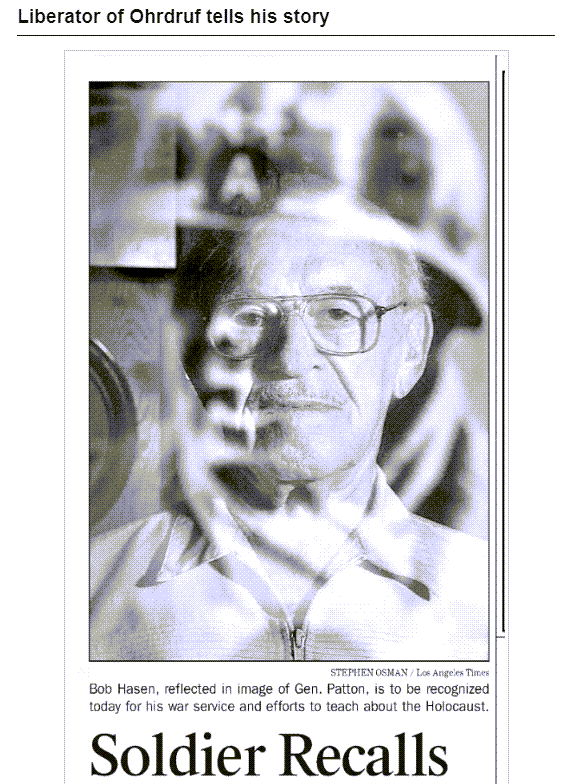
Newspaper article found
Newspapers as a Replacement for Lost Records
A lot of these soldiers’ military personnel files were gathered up and sent to the National Personnel Records Center where they were stored. It was in St. Louis, Missouri. Lisa, you’re probably familiar with the fire that occurred there. In the 1970s the facility caught fire, and between 16 and 18 million personnel records were destroyed. And so many of us that are trying to do research on our ancestors, we no longer have their military papers. Newspapers are a wonderful way to try to reconstruct their story and to understand the experiences that they endured while they were in the armed services.
Search Beyond the Time and Place
(18:35) Lisa: I noticed as you made your newspaper discoveries that you moved out from those very local papers that you knew where you were finding his name, and you’re reached into newspapers across the country for these kinds of stories from people who may be served right next to him, or who saw the same things he did. And I noticed some of these were fairly recent newspapers. It’s a great example that we can pull from something maybe from the 90s, or from 2005. Something like the soldier’s recollections article that you found. We have this wealth of information that spans so many decades and potentially holds these stories.
Jenny: You’re exactly right, Lisa. It’s common, particularly with monumental anniversaries, that you might see the newspaper going back to soldiers 20 years, 50 years later and saying, ‘it’s the 50th anniversary of the liberation of Ohrdruf. Can you tell us about your experience?’ For me, these papers were able to tell the story that my grandfather couldn’t. They were able to shed light on what he experienced when he wasn’t willing to talk about it.
Lisa: You’ve already found so much. What else did you pull out of newspapers?
Jenny: Well, now that he had endured the Battle of the Bulge, and he had participated in the liberation of this concentration camp, we are close to the day things were getting better, and the war was starting to wind down. It wasn’t too long until I came across a discharge notice. My grandfather had been discharged in October 1945. I was able to find that discharge notice in his little local hometown paper. I learned that his unit was one of the few units that received the Presidential Citation award, and that he received a Silver Star award. I learned about some of his military decorations.
So, that’s another great tip when you’re searching for your ancestors. If they were wounded, if they received awards, if they were taken prisoner of war, all of those are likely to be mentioned in the paper. Search for some of those things, in addition to battles and places and anything that might be able to help you reconstruct their military story.
How One Newspaper Article Can Lead to the Next
In 1945, Lamar came home. I found an article in a Salt Lake City paper. It listed all of the Utah soldiers that were heading home. At the bottom of the article, I found listed Private First Class, Lamar Norton. And what’s great about this is it tells me what ship he came home on! That gives me a further avenue to research. I can go to the newspapers, and I can learn about that journey. I can read about when that ship docked in New York, perhaps there was rough weather or sickness or a death on the journey. I can find out all about that now that I have the name of the ship.
I then found a notice saying that he has now returned home, reunited with his family, and parents and that he was recently discharged. So, their family is being reunited and moving back in together. And I’m continuing to put this story together. You can kind of see how much context and color these newspaper article provide for his military experiences in the newspaper.
Newspaper.com Search Techniques
(22:37) Lisa: That’s terrific! As you found each one, did you use any special techniques? Can we use things like quotation marks around his name as we can in Google? You mentioned in the very first article that you found that you had to separate the name Lamar Norton and not have the first and last name right next to each other because they might appear separately in an article or both names might not appear clearly to be read by the search engine. Can you tell Newspapers.com, I want this name to appear first name last name together?
Jenny: You absolutely can! At the newspapers.com homepage I can enter Lamar Norton. And yes, one of my favorite strategies is to add quotation marks before and after his name. That is going to only return results where those two names appear together in that order. Instead of every mention of Lamar, and every mention of Norton, I’m only going to have results that are in Lamar Norton.
Be sure to take advantage of the map off to the right side of the webpage. You will see all of the states have different colors. If there is a gray state, that indicates that there is no mention of Lamar Norton. The darker the color gets the more mentions there are of what you searched for. When I clicked on Utah which was the darkest red, I see there are 251 results for Lamar Norton. And it’s kind of cool right that it also breaks it down by county. I know that for a while Lamar lived in a number of these counties, so I can actually search through the various counties and see if that is my Lamar Norton.
Lisa: I see a timeline at the bottom of the screen as well, so we can really target one particular area of time as well.
Jenny: You absolutely could! You can also do that up at the top of the page. Maybe I only want to know about his military experiences. I can search 1941 to 1945. And I have 42. Matches. A lot of them are him talking about his military experiences. So many of these are the Vernal Express, the little newspaper in the area where he lived. I can use these filters by year as well. Maybe he’s landing in Utah and a New York paper does an interview. I don’t want to just have Utah results. I can remove the state, and I can make it as wide or as narrow as I want. I would really recommend just playing with the dates. Maybe your ancestor gave an interview to the paper about their World War II experiences, but it was in the 1990s. Don’t limit yourself. If you want to know World War II history, the information might not be in World War II years. You might find it at a later date.
Lisa: That’s a great point. And a great point about not necessarily limiting yourself to his state, because I did notice when he was coming home with the Utah troops that was a newspaper from New York, right?
Jenny: Yes, because the Liberty ship had landed in New York. Exactly.
Alerts for New Newspapers at Newspapers.com
(26:20) Lisa: Now I see an Alert Me button. I’m guessing Newspapers.com is continually adding newspapers all the time. Is there a chance that it can tell me if something new gets loaded onto the website?
Jenny: Yes. You can set up an alert. WE are constantly adding new papers. In fact, we hit a milestone a few weeks ago, 750 million pages of newspapers. You’ll find a counter on the home page. In fact, in the past week and a half, we’ve added another 5.3 million pages.
You can set up an alert for any search you want. Then, if there’s new content that meets the criteria, you will get a notice that there is a new article that mentions it.
Keep Searching in Newspapers
(27:23) Lisa: Any other tips about how people can find information about their ancestors?
Jenny: Keep searching! I found a newspaper article that mentioned something I’ve heard about many times in my life. It’s 1949, a few years after Lamar returned home, and he and his young family have a new baby and they are living in Clearfield, Utah. His little daughter who happens to be my mother was returning home from kindergarten and got hit by a truck. Well, you can imagine how traumatic this would be to this little family and what an impact that would have on their lives. You can imagine as a father, and that being your little daughter, how traumatic that would be and what an impact that would have on you and your story.
Lisa: Oh my gosh! Obviously, she survived all that. But it just goes to show that there are just so many pieces to the puzzle. I see many names listed in that article. I imagine that gave you a wonderful opportunity to search for some of those people too.
Jenny: And you know what, I know who these people are because they’re in my family tree. But if you didn’t know and you’re trying to discover your family tree, this would be a great help. People are rushing to the hospital, and there’s been an accident, and it’s a familiar surname. I can look through all of these names and ask, “who is Harvey Hollander?” “Who is Mrs. Harvey Hollander? “ I can do some research and search for her in the paper and get an idea of how she fits into this family and into this story.
Downloading and Organizing Newspaper Research
(29:12) Lisa: I see there are buttons for downloading and editing the clippings we find. We’ll definitely have you come back and show us how you organize all this stuff. Obviously there’s a potential here to find a lot of items and we’ll want your best strategies for keeping newspaper articles organized. Will you promise to come back and help us get organized?
Newspapers Expand Our Ancestors’ Stories
(29:34) Jenny: I would love to. And you know, when you are putting together a story for your ancestor, this is such a wonderful way to do it because they become more than a name on paper, they become real and relatable. It’s no longer just this sterile name. It’s a person whose life impacts your life, and you get to tell their story. And like you said, they don’t have to be famous to be mentioned in a newspaper. They don’t have to be a notable person. My grandfather was the most ordinary person, but I was able to kind of reconstruct things that impacted his life and must have impacted how he parented and how he raised his family. And that impacts how I was raised in it. We’re all connected.
Lisa: Very well said. Even with a man who didn’t necessarily want to come back and talk about his experiences, who was a more private person, you learned so much through your newspaper research.
Jenny, this has been fascinating. We all need to make our list of what we know so far about our ancestors and then go our and search these newspapers to find gems like these waiting for us. Newspapers.com is certainly a great place to do that.
Thank you so much for coming and sharing your grandfather’s story.
Jenny: Thank you so much, and I just wish everyone the best of luck as you dive into your own research. I’m so excited for you to find amazing newspaper clippings about your family.
Newspapers.com 20% Discount
For a limited time get 20% off Newspapers.com here. Use our coupon code: genealogygems
Resources
Download the ad-free Show Notes handout for Premium Members.
Listen to the Genealogy Gems Premium Podcast on Android Devices
FOR ANDROID USERS: How to Get the Premium Feed on Your Android Mobile Device
 Recommended app: Podcast Addict for Android, available in the Google Play Store.
Recommended app: Podcast Addict for Android, available in the Google Play Store.
Follow these steps to set up the Premium Podcast using the Podcast Addict app for Android. Examples shown below are on a tablet, so keep in mind that it may look slightly different on your device.
1. Download the Podcast Addict App

Podcast Addict app

Google Play Store
On your device, go to the Google Play Store and download the Podcast Addict app.
(*Note: If you’ve never used the Google Play store you may be required to set up an account, including payment information. This is unrelated to Genealogy Gems, but necessary in order to download apps from the Google Play Store.)
Recommended app: Podcast Addict for Android, available in the Google Play Store.
Follow these steps to set up the Premium Podcast using the Podcast Addict app for Android.
NOTE: Examples shown below are on a tablet, so keep in mind that it may look slightly different on your device.
2. Add the Genealogy Gems Premium Podcast Feed
Tap the + icon to add a feed

Tap “RSS Feed, YouTube/Twitch Channel, Soundcloud URL”

In the “RSS feed URL” field, copy and paste this address to ensure it is exactly correct with no extra spaces at the end (the feed address is case sensitive):
https://lisalouisecooke.com/Premium_Feed/feed.xml
- Check the box for “Authentication (Premium Podcast)”
- Type in your Genealogy Gems Premium Membership username and password. You MUST use your membership username, NOT your email address.
- Tap “Add”

Your Podcast home screen will now have the Genealogy Gems Premium Podcast.

Tap the podcast icon. It may appear yellow like this or it may be our logo) to reveal all episodes, starting with the most recent episode at the top of the list.
3. Downloading Episodes
You can download episodes so that you can listen offline, without an internet connection or using your device’s cellular data. Download an episode by tapping the down arrow icon on the right:
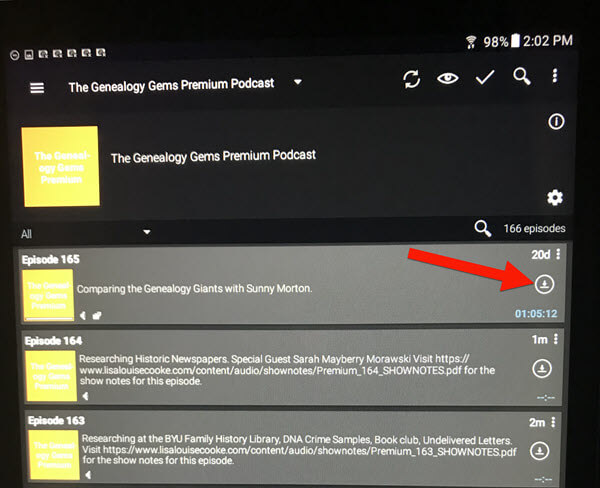
Once the episode is downloaded, a play button will appear that you can click to listen. A small download icon will appear indicating that this episode is downloaded to your device:
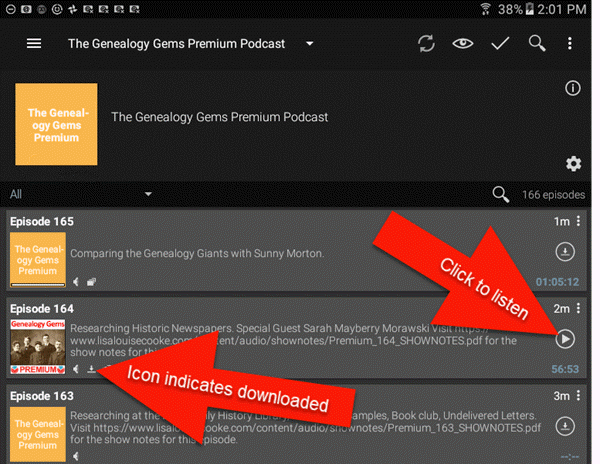
3. Listening to Episodes & Viewing Show Notes
When you open the app, tap the Genealogy Gems Premium podcast to access episodes:
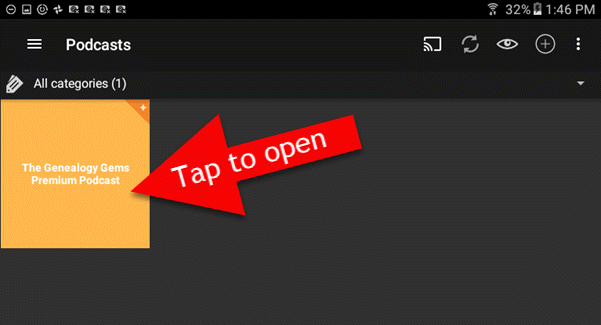
You can go straight to the episodes you’ve already downloaded through the app’s menu. Tap the three lines icon:
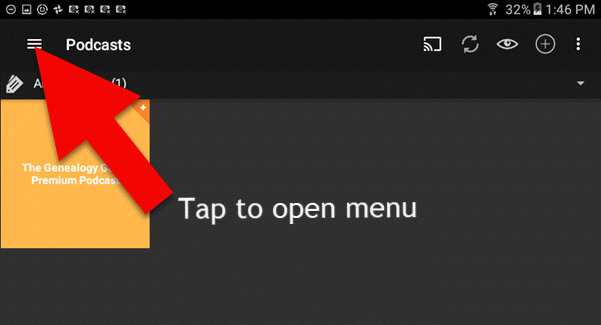
Then tap Downloaded episodes:
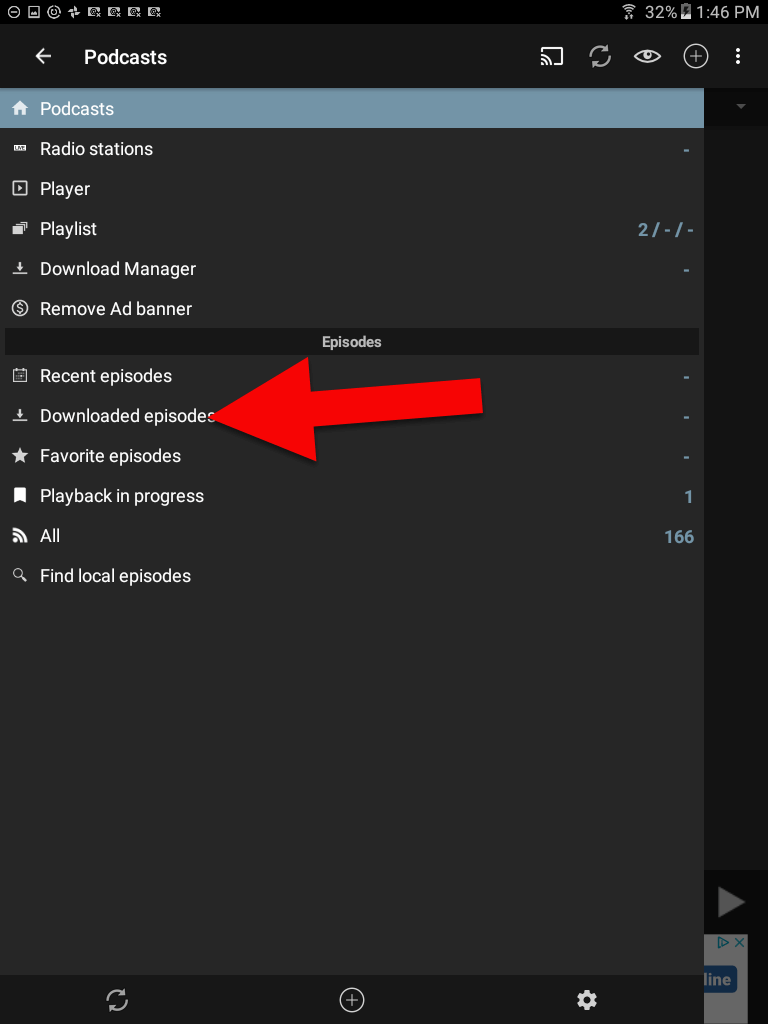
On this screen are only the episodes you have downloaded for offline listening. To return to all episodes just tap the 3 line icon in the upper left corner.
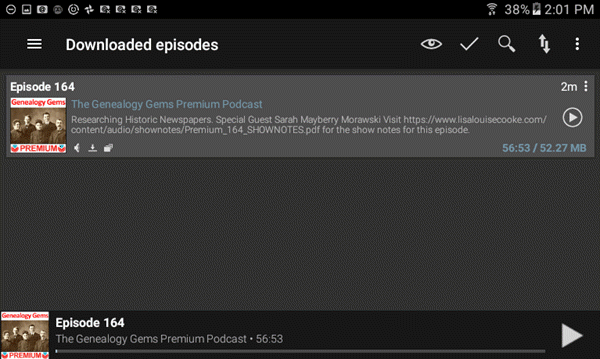
4. Deleting Downloaded Episodes
After you have listened to a downloaded episode, you can delete it to free up the space on your device. (Don’t worry, all of the episodes are still available through the main podcast feed in Podcast Addict.) To delete an episode in the Downloaded Episodes area, tap the 3 dots icon on the episode you want to delete:
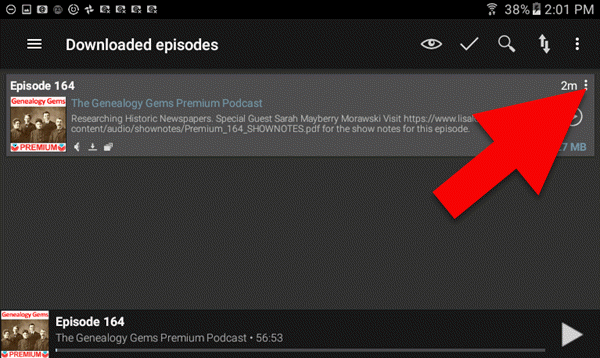
(Note: If you want to delete all the episodes that you’ve already played, click the 3 dots icon at the very top of the right-hand corner, and then tap “Delete Played Episodes”)
On the page for that downloaded episode tap the trash can icon to delete it from your device:

Need More Help?
If you’re experiencing error messages or other technical difficulties, please visit our Premium eLearning FAQ page and head to the Troubleshooting section towards the bottom. You’ll find answers to the most common causes of problems and solutions and tips to fix them.
Ellis Island Passenger Arrival Records: Relatives Now Searchable at MyHeritage
Millions of Ellis Island passenger arrival records include the names of the arrivals’ relatives, but those names haven’t been searchable in online indexes–until now. MyHeritage has added over 26.6 million relatives’ names to its passenger list collection and even digitally stitched together the pages for easier reading.
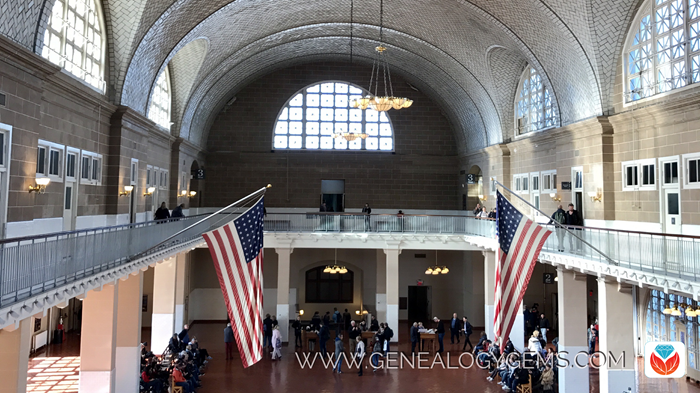
New Names in Ellis Island Passenger Arrival Records at MyHeritage.com
Recently, I interviewed Ellis Island experts and shared my ongoing immigrant ancestor discoveries in the free Genealogy Gems Podcast (episode 211) and Premium Podcast (episode 153). I’ve made progress by searching Ellis Island records at different websites and by learning about clues we often don’t recognize in the records themselves. So I was pleased to hear that MyHeritage has added its own Ellis Island and Other New York Passenger Lists (1820-1957) collection and given it two unique features:
- Its 94 million names include–for the very first time–26.6 million names of the relatives of passengers. Passenger lists recorded both the name of a relative or friend living at the arrival’s last residence and the name of a relative or friend the passenger was to visit in this country. Many times, this chain of names represents family links between an immigrant’s old and new homes. MyHeritage has indexed these names; their press release says they’re the first to do so. A quick check of Ellis Island collections at Ancestry.com, Ellis Island.org, Steve Morse’s One-Step Pages and FamilySearch confirms that none of them mention relatives’ names in their index descriptions.
- MyHeritage has stitched together the two-age passenger manifest images, which I find pretty cool. It’s much easier not to miss the fact that there is a second page for each record, and to trace your ancestor’s line straight across the page. Here’s what it looks like:
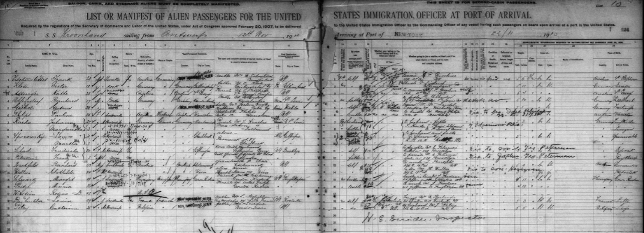
Searching for Ellis Island Immigrant Ancestors
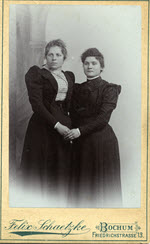
Louise (on the right) just before departure for America.
Interestingly, this search engine is the first one of any genealogy records site to pull up both sets of arrival listings for my great grandmother Louise Sporowsky and her daughter Martha, whom I talked about in Genealogy Gems Premium Podcast Episode #153.
I’m very fortunate that by a quirk of circumstance Louise and Martha were recorded twice in the same passenger list. But because each entry had variations, they’ve never come up in the same search – that is until now!
The search was a simple one: the name “Sporowksy” & 1910 as the year of arrival:
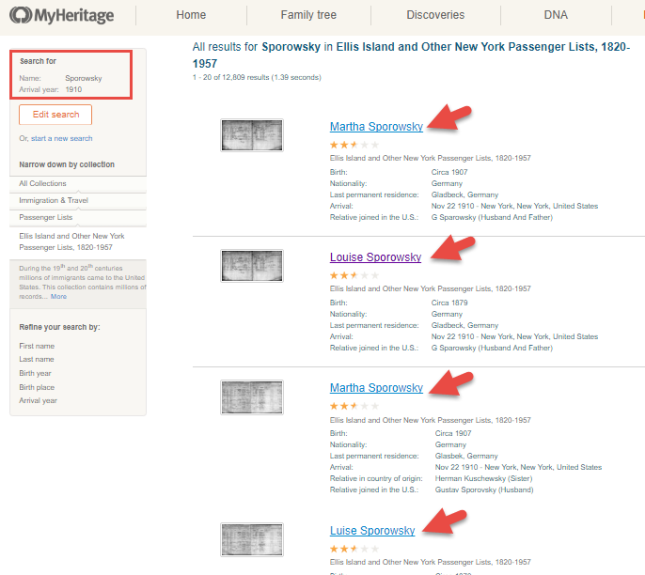
Premium Members may listen to that episode to find out why Louise and Martha had two passenger listings for the same crossing and what I learned from looking at both of them.
Here’s a tip: There isn’t a separate search field for relatives’ names in the MyHeritage index. I wondered about that, and Daniel Horowitz at MyHeritage confirms that you just use the regular search fields for first and last names of the passenger’s relatives. Results will include both the passengers themselves and the relatives they named.
Learn More about Ellis Island
Listen to the free Genealogy Gems Podcast episode #211: Barry Moreno, Historian at Ellis Island, talks about the life cycle of this busy U.S. immigration station (1892-1954) and his research into the lives of Ellis Island employees.
Disclosure: This article contains affiliate links and Genealogy Gems will be compensated if you make a purchase after clicking on these links (at no additional cost to you). Thank you for supporting Genealogy Gems!


